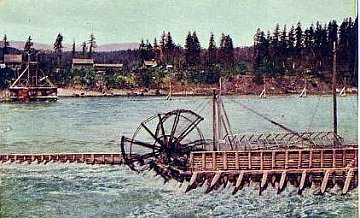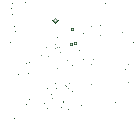~~* The Singing Falls Stream Restoration Project *~~
 ϕ
ϕ
~~* Living with the watershed in mind *~~
~~*Keeping clean with fish*~~
Every year, some 200 million pounds of toxic and hazardous pollutants are discharged into America's waterways. The material comes from factories, farms, roadways--and some of it comes from the kitchen sinks and cleaning cabinets of ordinary homes.
Some fish populations are showing the effects of these poisons in their environment. In highly polluted areas of the Puget Sound, for example, many English sole, a bottom-feeding fish, show liver tumors and damaged reproductive organs. Studies of juvenile salmon in Puget Sound migrating though polluted urban estuaries as compared to clean estuaries on their way to the sea show damage to their immune and reproductive systems. Apparently pollutants are being concentrated in the small aquatic insects that are the food of the hungry and quickly growing salmon. It is not yet known exactly which chemicals or environmental factors are responsible. But in light of the current struggle to save dwindling populations of salmon in many West Coast rivers, fishery scientists are looking seriously at the role of water pollution in salmon decline.

Columbia River “Fish Wheel”
Many of the hazardous chemicals in the water are exotic combinations that emerge from factory pipes. But some are closer to home--lye, boric acid, chorine, petroleum-based cleansers and polishes, fertilizers and pesticides, roach powder and other materials stored under the sink or in the garage of most homes.
While households play a comparatively minor role in adding pollutants to our waters, even small amounts can contribute to water quality problems and are highly toxic to fish and the aquatic insects on which they prey. Substances washing down the drain can affect water quality in other ways too. Material in the water can increase turbidity (cloudiness), limiting biological activity and in extreme cases even clogging fish gills. Ammonia and phosphates in everyday household cleansers can spur algae growth beyond normal levels (a process called “eutrophication”), possibly depleting oxygen levels in the water and threatening fish survival.
Everyone can contribute to the effort to protect salmon and other fish populations by taking great care about what goes down the drain. In most cases, there are gentler alternatives to conventional cleansers and detergents--often homemade concoctions are less toxic, work just as well and are far cheaper to boot. And everyone can make sure that household pesticides and other poisons are never flushed down the drain and eventually into the river.
Here are some of the steps that every household can take to make cleaning day compatible with salmon:
Dispose of pesticides properly (rat, slug, and ant poison, no-pest strips, etc.); never allow them to reach waterways. Store wastes and empty containers in a covered repository. In most areas there are periodic household hazardous waste collection days--for information, contact local sanitation departments or extension agents. Try to avoid pesticide use in the first place by sealing all points of entry, removing sources of food and water for insects and rodents, treating pets for fleas with soapy water and a flea comb, attracting slugs with beer, and attacking ants with boiling water.
Get acquainted with the virtues of vinegar, baking soda, lemon juice and borax. Most household cleaning projects can be tackled with combinations of these ingredients, plus water and liquid soap. Commercial drain cleaner, for instance, contains lye, which is extremely toxic--a cup of baking soda followed by a half-cup of vinegar, rinsed with hot water after the drain has been tightly covered for a minute, will usually work (or try to solve the problem with a plumber's helper, snake or drain auger).
Take care with old paint (the average household has four gallons stored away). Try to give large quantities to organizations (such as theater groups) or individuals who can put it to use. Don't dump paint on the ground; it can pollute groundwater. Dispose of small quantities along with other household hazardous waste at collection sites. Thinner can be stored and re-used once paint has sunk to the bottom.
Educate others, especially children, about the connection between the drain and the fish's home. For information on how to create less-toxic cleaning products, contact your county extension office, state office of water quality, or Pacific States Marine Fisheries Commission, 45 SE 82nd Drive, Suite 100, Gladstone, OR 97027-2522.
stream index
top






